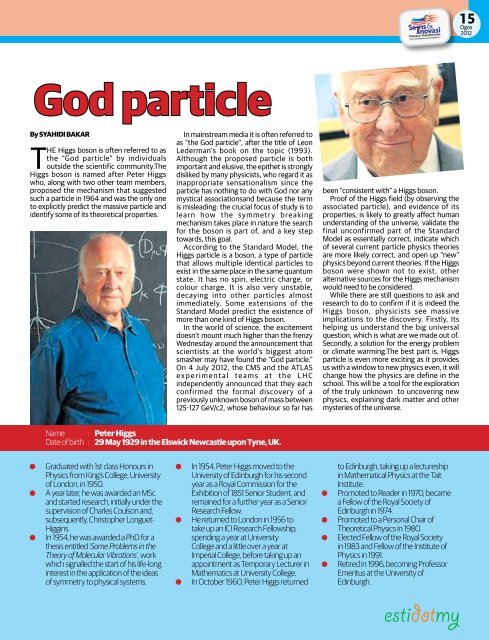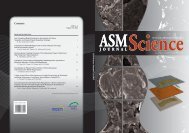Teknologi Mega Sains - Portal Rasmi Akademi Sains Malaysia
Teknologi Mega Sains - Portal Rasmi Akademi Sains Malaysia
Teknologi Mega Sains - Portal Rasmi Akademi Sains Malaysia
- No tags were found...
Create successful ePaper yourself
Turn your PDF publications into a flip-book with our unique Google optimized e-Paper software.
15Ogos2012God particleBy SYAHIDI BAKARThe Higgs boson is often referred to asthe “God particle” by individualsoutside the scientific community.TheHiggs boson is named after Peter Higgswho, along with two other team members,proposed the mechanism that suggestedsuch a particle in 1964 and was the only oneto explicitly predict the massive particle andidentify some of its theoretical properties.In mainstream media it is often referred toas “the God particle”, after the title of LeonLederman’s book on the topic (1993).Although the proposed particle is bothimportant and elusive, the epithet is stronglydisliked by many physicists, who regard it asinappropriate sensationalism since theparticle has nothing to do with God nor anymystical associationsand because the termis misleading: the crucial focus of study is tolearn how the symmetr y breakingmechanism takes place in nature the searchfor the boson is part of, and a key steptowards, this goal.According to the Standard Model, theHiggs particle is a boson, a type of particlethat allows multiple identical particles toexist in the same place in the same quantumstate. It has no spin, electric charge, orcolour charge. It is also very unstable,decaying into other particles almostimmediately. Some extensions of theStandard Model predict the existence ofmore than one kind of Higgs boson.In the world of science, the excitementdoesn’t mount much higher than the frenzyWednesday around the announcement thatscientists at the world’s biggest atomsmasher may have found the “God particle.”On 4 July 2012, the CMS and the ATLASe x p e r i m e n t a l t e a m s a t t h e L H Cindependently announced that they eachconfirmed the formal discovery of apreviously unknown boson of mass between125-127 GeV/c2, whose behaviour so far hasbeen “consistent with” a Higgs boson.Proof of the Higgs field (by observing theassociated particle), and evidence of itsproperties, is likely to greatly affect humanunderstanding of the universe, validate thefinal unconfirmed part of the StandardModel as essentially correct, indicate whichof several current particle physics theoriesare more likely correct, and open up “new”physics beyond current theories. If the Higgsboson were shown not to exist, otheralternative sources for the Higgs mechanismwould need to be considered.While there are still questions to ask andresearch to do to confirm if it is indeed theHiggs boson, physicists see massiveimplications to the discovery. Firstly, Itshelping us understand the big universalquestion, which is what are we made out of.Secondly, a solution for the energy problemor climate warming.The best part is, Higgsparticle is even more exciting as it providesus with a window to new physics even, it willchange how the physics are define in theschool. This will be a tool for the explorationof the truly unknown to uncovering newphysics, explaining dark matter and othermysteries of the universe.Name : Peter HiggsDate of birth : 29 May 1929 in the Elswick Newcastle upon Tyne, UK.lllGraduated with 1st class Honours inPhysics from King’s College, Universityof London, in 1950.A year later, he was awarded an MScand started research, initially under thesupervision of Charles Coulson and,subsequently, Christopher Longuet-Higgins.In 1954, he was awarded a PhD for athesis entitled ‘Some Problems in theTheory of Molecular Vibrations’, workwhich signalled the start of his life-longinterest in the application of the ideasof symmetry to physical systems.lllIn 1954, Peter Higgs moved to theUniversity of Edinburgh for his secondyear as a Royal Commission for theExhibition of 1851 Senior Student, andremained for a further year as a SeniorResearch Fellow.He returned to London in 1956 totake up an ICI Research Fellowship,spending a year at UniversityCollege and a little over a year atImperial College, before taking up anappointment as Temporary Lecturer inMathematics at University College.In October 1960, Peter Higgs returnedllllto Edinburgh, taking up a lectureshipin Mathematical Physics at the TaitInstitute.Promoted to Reader in 1970, becamea Fellow of the Royal Society ofEdinburgh in 1974.Promoted to a Personal Chair ofTheoretical Physics in 1980.Elected Fellow of the Royal Societyin 1983 and Fellow of the Institute ofPhysics in 1991.Retired in 1996, becoming ProfessorEmeritus at the University ofEdinburgh.

















